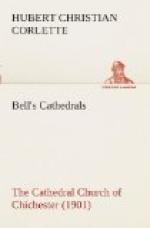Of #Richard Fitz-James# (1503-1508) and his administration there is but little information.
With #Robert Sherburne# (1508-1536) we come to the close of a long period of ecclesiastical history—one during which the distinctly Christian, as opposed to the pagan, principles and forms of art had been developed. As bishop at Chichester he represented the Church and those principles which then in the west were taught in her name. Accordingly he protested against “the King’s most dreadful commandment concerning (with other things) the uniting of the Supreme head of the Church of [? in] England with the Imperial Crown of this realm; and also the abolishing and secluding out of this realm the enormities and abuses of the Bishop of Rome’s authority, usurped within the same.” He wrote thus in 1534 to Cromwell. And obeying this command from the civil authority, he caused these orders to be published throughout the diocese. As a subject he obeyed his king; but, being honest, he could not as a bishop and a man disregard his principles when he found such obedience involved their denial. Consequently he resigned the see in 1536.
#Richard Sampson# (1536-1543) took part in the Reformation movement. Although he had defended the principle that the king was to be considered “high governor under God, and Supreme head of the Church of England,” his principles appear to have been easily affected by the political weather that prevailed. His attitude in favour of every principle involved in the acceptance of the papacy appears in the support he gave to doctrines which had been rejected by the party of reform. He no doubt feared the results that might follow upon another attempt to adapt the Church’s constitution to changed conditions.
In the time of #George Daye# (1543-1552) the pendulum moved again across the face of the political and ecclesiastical clock. He was a man whose convictions led him to support those same six articles which had been upheld by Bishop Sampson; and he attempted to prevent the introduction of the first prayer-book of Edward VI. in 1549, as well as the destruction of the earlier service-books in the following year. He was a man to be respected, for in the face of general opposition he proved that his convictions on important affairs were not ready to change at the sudden bidding of a new authority which he was unable to recognise. As he was not to be persuaded that his position was wrong, he was removed from the see towards the end of the year 1551. But we meet him again presently, for Bishop #John Scory# (1552-1554), who took his place, retired soon after Mary’s accession. Bishop Daye came back to favour, preached at the coronation, reoccupied the see, and was now “a mighty busy man.” [37] He caused some recent orders to be reversed by reviving the use of the earlier forms of liturgy, restoring the older ceremonial, and again setting up those altars in the churches which should never have been broken down. In his own words




